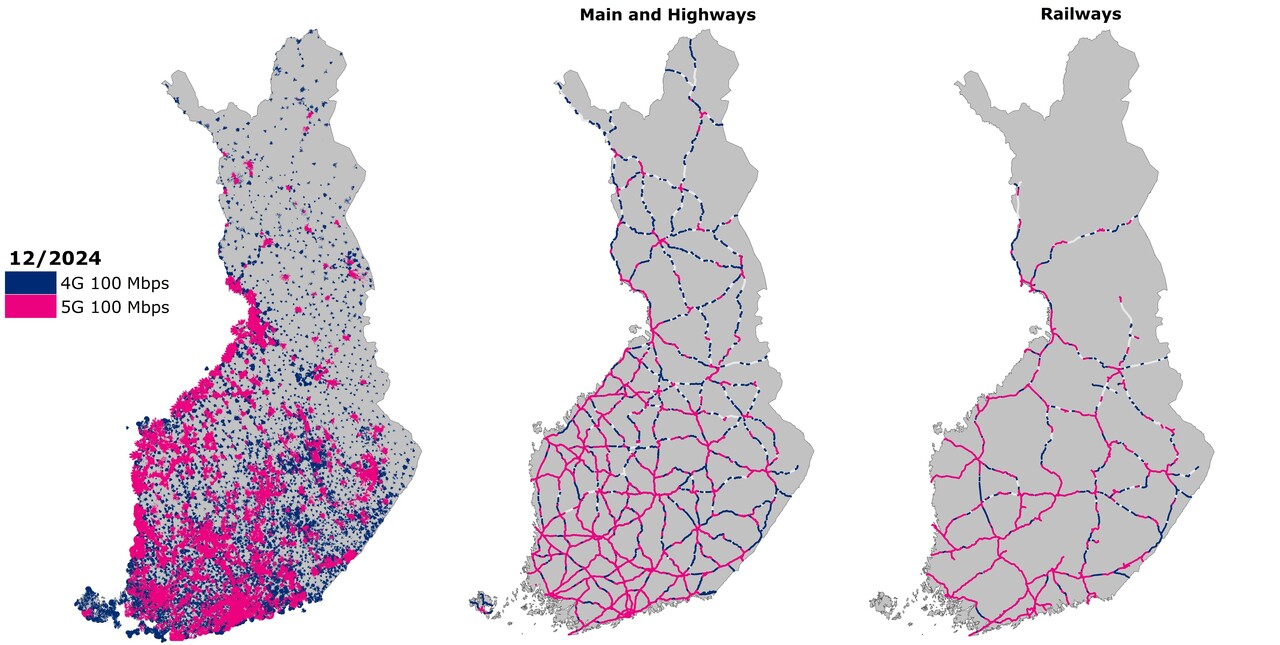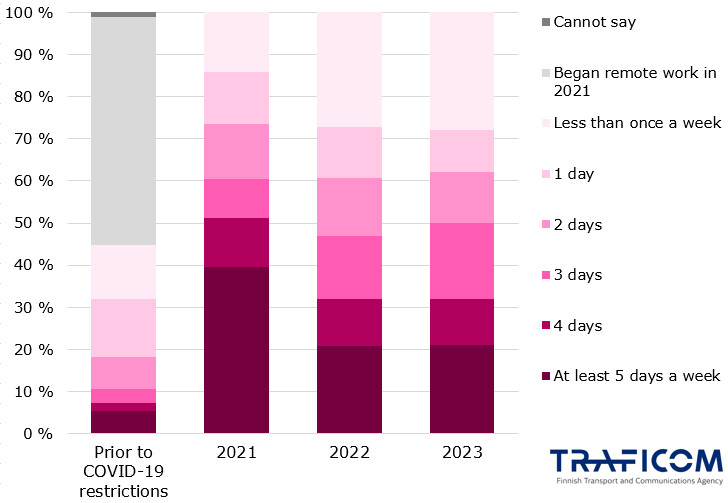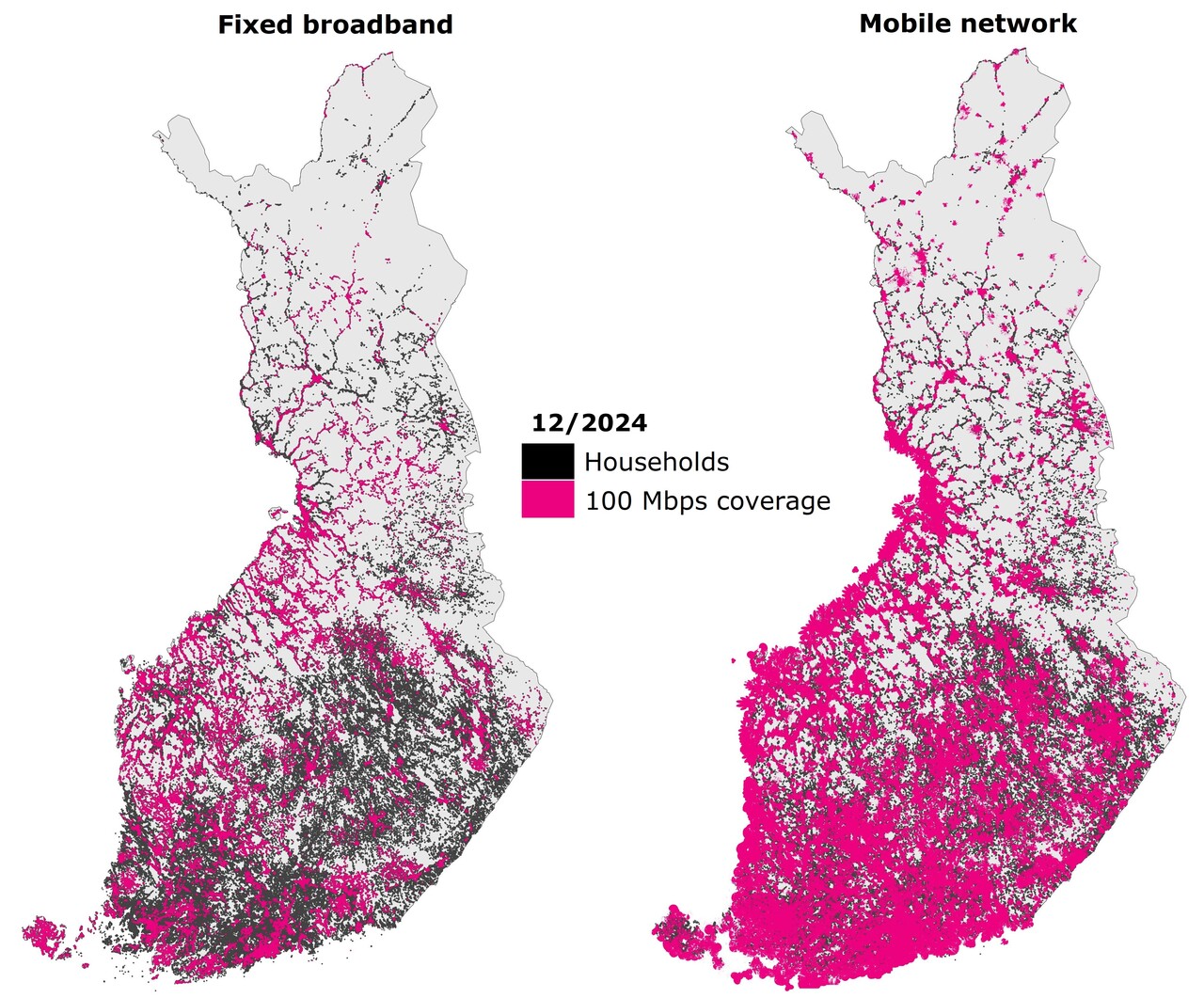This situational picture provides information on the coverage of communications networks providing fast download speeds of at least 100 Mbit/s especially along Finland’s road and railway network. In addition to this, the situational picture includes other supplementary information about fast communications networks and related changes. The situational picture is primarily updated once a year. The information is produced by the Finnish Transport and Communications Agency Traficom. The information is part of the situational picture of the accessibility of the transport network.
COVERAGE OF 5G NETWORKS INCREASING FAST
The coverage of fast mobile communications networks has expanded over the past few years. The construction of 5G networks is concentrated especially in cities and urban areas and the networks have expanded relatively fast. The implementation of lower 5G bands is only just beginning. In the next few years, they are likely to have an impact on the coverage of 5G networks also in sparsely populated areas.
Data transfer solutions in transport today and in the future
A variety of radio systems are used in transport now and will be in the future. The systems used for safety radio communications in maritime transport and aviation are globally agreed radio systems related to speech, data transfer and positioning. They take advantage of both terrestrial networks and satellite technology. In the future, rapidly developing services taking advantage of mobile communications networks and satellite technology will supplement the radio systems of maritime transport and aviation.
The current 4G and 5G networks have not been built and optimised to cover water bodies or to be used from the air. In spite of this, the availability of mobile communications networks is good in some places on inland waters, on the coast and in the archipelago as well as in the low airspace. Larger vessels have connections of their own that are based on WLAN base stations, repeaters of the mobile communications network or base stations on board the vessel. Especially in unmanned aviation, flights operating out of sight will in future need support from appropriate connections based on the 4G/5G mobile communications network.
In Finland, the network used for oral communication connections on railways is the public authority network VIRVE, which is based on TETRA technology. The future railway communications system in Finland will be based on 5G technology and the Digirail project has been set up for developing it.
The development of mobile communications connections is important not only for digitalisation and automation in road and rail traffic, but also for unmanned aviation and maritime transport on the coast, in the archipelago and inland waterways. The different future transport applications will need a variety of communications services. For some purposes, the most important criterion is not the highest possible speed but the availability of the service comprehensively in the whole country and also in the air. For some, consistent quality and very low latency may be critical properties. Similarly, the speeds of data transmission networks are a challenge for applications that transmit large amounts of real-time video image from routes or vehicles to the network. This is because in mobile communications networks, significantly less capacity has usually been reserved for outgoing data transmission than for incoming data transmission to users.
In addition to the speed and coverage of 5G networks, their technical properties will also develop. We can expect that in the future, the aim will be to ensure that some areas of application in transport will have a certain capacity and service quality that are not dependent on other users of the network. The development of 5G technology will provide operators with the tools required for implementing these tailored network services for the needs of transport.
Situational picture of fast communications networks
In this situational picture, fast communications networks refers to communications networks that can offer the minimum download speed of 100 Mbit/s from the network to the user. The sections on highways, main roads and the rail network also discuss the coverage of a faster mobile communications network with the download speed of 300 Mbit/s. When realised, these speeds will be sufficient for all of the most typical current use cases.
In addition to possible obstacles in the terrain, factors such as the number of persons using the network and the user’s distance from the base station affect the connection speed realised in mobile communications networks. The coverage details of the networks presented in connection with the situational picture are based on the coverage of the networks enabling the speed in question at least to one user in an ideal situation. For the above-mentioned reasons, the speeds achieved in situations where the network is actually used, are often lower than those described here.
The base stations of mobile communications networks are usually connected to the backbone network with fibre option connections. The expansion of fast mobile connections networks therefore also partly describes the building of fixed fibre optic networks near transport routes. Whether the fibre optic networks can be used, for example, for the needs of the separate route infrastructure that will serve smart transport in the future depends on the way they have been implemented. In practice, it will be technically difficult to later join fibre optic connections that have been built only for connecting to the backbone network unless preparations for this were already made then the networks were built.
Coverage of fast mobile communications networks in the road and railway network
In Finland, communications networks are mainly built on market terms with private financing. Investments are therefore made on commercial grounds and concentrate primarily in areas with a large number of potential users. For example, high capacity 5G networks operating in the 3.5 GHz band have initially been built primarily to cities and transport nodes. There are no separate obligations for the coverage of the network in the network licences for this frequency band, whereas licences for the lower 700 MHz band include an obligation to build the network to cover all highways, main roads, regional roads and connecting roads as well as the state-owned rail network. In addition, the coverage-related obligation is 99% of the population. Other frequency bands used by the operator may also be used to implement the coverage-related obligation. When this lower band is used, it is possible to build geographically more extensive coverage more economically. However, the frequency band available is narrower than the higher bands and less capacity is available.
If the aim is to cover the road or railway network extensively with high-capacity 5G networks, it may be necessary not only to expand the fibre optic networks but also to develop new kinds of cooperation and business models. Joint construction with all the different networks required in civil engineering as widely as possible is also important. Additional building of fibre optic networks means the installation of ground cables, which is a considerable investment cost. When building the road infrastructure, it would be sensible to prepare for the future needs of communications networks to the extent this is possible, for example, by already building cable channels, protective conduits and cable wells. Building additional communications networks by using them is more cost-effective and possible without having to repeat digging work in road areas.
According to the licence-related obligation, the so-called basic coverage of mobile networks practically covers almost the entire road and railway network. However, basic coverage does not guarantee any specific speed to the user of the network. According to this situational picture, fast 4G mobile communications networks covered about 71% of the highway and main road network at the end of 2024. Coverage had improved by five percentage points in one year. Similarly, fast 5G networks covered about 48% of the highways and main roads. The faster 4G and 5G networks enabling the downloading speed of 300 Mbit/s together covered about 37% of the highways and main roads. The coverage of fast 4G networks on the rail network was about 74% at the end of 2024. Fast 5G networks covered about 54% of the rail network. The 4G and 5G networks enabling faster connections of 300 Mbit/s covered a total of about 42% of the railway network (Figure 1).
To improve the connections for passengers, WLAN base stations and repeaters of the mobile communications network have been installed on many trains. However, the connections to these systems on board come from external mobile communications networks. The basic coverage of mobile communications networks on the railway network is good and even fast mobile communications networks cover more than half of the railway network, as described above. However, the challenge is the adequacy of the capacity of the current 4G and 5G networks along railway lines as the momentary need for capacity for a full passenger train may be very high. As already stated, the above-mentioned figures concerning the coverage of the fast mobile communications network indicate the network coverage for one person in an ideal situation. Different operators are working together to find solutions to these capacity challenges.

Multilocation work has increased
The increase in multilocation work may have a considerable impact on the transport performance. On the one hand, the volume of transport may fall. On the other, a transition may take place from one mode of transport to another if a person who has previously used the comprehensive public transport in the city or the opportunities provided by pedestrian or bicycle traffic changes over to working remotely at the holiday home in a sparsely populated area. In that case, commuting ends but the trips to services during leisure time may become significantly longer because services such as shops, the post office and similar are not necessarily available at close range. It is also very possible that the only appropriate means of transport is a private car.
The COVID-19 pandemic changed the ways of working slightly and permanently increased multilocation work for a part of the workforce (Figure 2). However, based on a consumer survey carried out by Traficom, about one half of the working-age population does not telecommute at all. The most typical reason for this is that the nature of the work does not allow telecommuting.

High-quality communications connections are an essential precondition for an increase in telecommuting. The connection speed required for remote work to run smoothly and whether a fast connection is also required from the user to the network depend on the nature of the work. The size of the household in turn contributes to the total number of people using the internet connection at home at the same time. During the COVID-19 pandemic, a family of four may have had both parents working remotely and two school-age children, who all have needed the home broadband connection at the same time during the working and school day.
There has already been a strong increase in the amount of data transferred in mobile communications networks for several years. Based on statistical data, the COVID-19 pandemic did not cause a clear growth spike in the amount of data traffic in mobile communications networks.
At the end of 2024, a fast fixed connection was available to 81 per cent of the population. A fast connection in the 4G mobile communications network was available to 96 per cent of households (Figure 3) and a fast connection in the 5G network to 92 per cent of households. The coverage of fast 5G networks increased by about 2 percentage points in one year. The increase in population coverage especially in the initial stage of building 5G networks has been fast as networks have been built in cities and urban areas with a high population density. The availability of mobile communications networks is defined outdoors in an ideal situation, so availability and the speed available to the user indoors are more limited that those stated here.

In addition to working at home, working from locations such as a holiday home has increased. At the end of 2024, a fast fixed broadband connection was available only for about 14 per cent of summer houses. A fast mobile communications network covered 68% of summer houses. A large proportion of summer houses was outside the coverage of fast mobile communications networks, which may partly limit the possibility to telecommunicate.